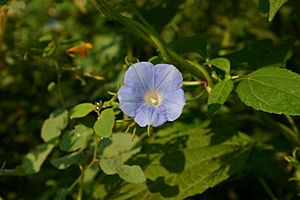Ivy-leaved morning glory facts for kids
Quick facts for kids Ivy-leaved morning glory |
|
|---|---|
 |
|
| Scientific classification | |
| Genus: |
Ipomoea
|
| Species: |
hederacea
|
The Ivy-leaved morning glory (scientific name: Ipomoea hederacea) is a beautiful flowering plant. It belongs to the bindweed family. This plant is a type of vine that loves to climb.
It originally comes from warm, tropical parts of the Americas. But now, you can find it in many places in North America. It grows from Arizona all the way to Florida. You can also see it further north in Ontario and North Dakota.
What it Looks Like
The Ivy-leaved morning glory is a climbing vine. It has stems that twist and turn as they grow. Its leaves are usually shaped with three lobes, like a clover. Sometimes, they can have five lobes or even be a single, smooth shape.
The flowers are very pretty. They can be blue or a rosy-purple color. The center of the flower is usually white. These flowers appear in summer and keep blooming until late fall. They grow in small groups of one to three flowers. Each flower is about 2.5 to 4.5 centimeters long and wide. The sepals, which are the small leaf-like parts at the base of the flower, are long and curve backward.
Where it Grows and Who Uses It
This plant is part of the natural world. It interacts with different animals. For example, white-tailed deer don't eat much of this plant. Its large seeds are sometimes eaten by birds like the northern bobwhite and other seed-eating songbirds.
The bright flowers are a favorite for some larger butterflies. These include swallowtails and fritillaries. The tiny ruby-throated hummingbird also visits the flowers.
How it Reproduces
The Ivy-leaved morning glory mostly reproduces by itself. This is called self-pollination. About 93% of the time, the plant pollinates its own flowers. This helps it make seeds without needing pollen from another plant.
Sometimes, the Ivy-leaved morning glory grows near a close relative called Ipomoea purpurea. When they grow together, the Ivy-leaved morning glory changes a little. Its anthers, which hold the pollen, grow closer to the stigma. The stigma is the part that receives pollen. This change helps the Ivy-leaved morning glory avoid getting pollen from Ipomoea purpurea. If it gets pollen from Ipomoea purpurea, the seeds won't grow. This would waste the plant's energy. So, this change helps the plant save energy and make healthy seeds.

